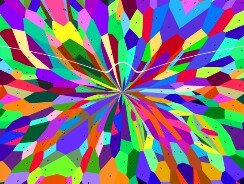PORTRAIT OF THE VOLCANO AS AN ARTIST
I grew up at the foot of the majestic Vesuvius volcano, admiring it from the balcony and later studying it until obtaining a degree in volcanology. Its presence deeply influenced my art. The volcano has long held a significant place in the Western world, serving as a powerful metaphor to understand creation, morality, and nature itself. It is a universally recognized object of power in the natural world. The containment of gases and lava, followed by their release in a violent eruption, has become a widely used symbol to describe explosions in human life, whether personal, cultural, or political in nature.
However, the subtler implications behind the image of a volcano as perceived by human society might be more complex to grasp. Eruptions reshape the faces of volcanic craters. Lava moves rocks, yet simultaneously creates them. Volcanic activity is inherently unpredictable; a volcano that has remained silent for a thousand years may suddenly decide to erupt violently, destroying entire cities, or simply emit a cloud of steam that alerts scientists to monitor its activities closely. It is this mutable personality that gives volcanoes vital and respiratory functions akin to those examined in humans by early psychologists like Freud, Jung, and Rank.
The unconscious proves to be a force with behaviors akin to any other natural force, such as a river, a desert, or indeed, a volcano. The volcano, in its paradoxical nature, is both shapeless and ordered, as it is the volcano itself that shapes its formless existence. In a philosophical sense, the volcano acts as an artist, existing both as a geological void and a physical form capable of emitting lava, gas, ash, and vapor that can be seen and recorded by the human eye.
An artist is primarily a creator, but much of the Western understanding of the modern artist stems from early 20th-century Europe, where artists no longer relied on wealthy patrons for their survival, often living in material poverty within the cultural underground. According to this particular cliché, largely derived from the Parisian art world, the "artist" was long engaged in an ongoing battle between the survival of their living body and their fervent creative passion. Similarly, the volcano embodies this duality, manifesting as a force of nature that grapples with its formless existence and its ability to shape the surrounding world. Thus, the volcano is a philosophical artist, a creator that finds its form and expression in the energy released through its eruptions. A primordial dance between chaos and order, life and destruction, reminding us of the complexity and wonder of the unconscious and nature itself.
MAURIZIO D'ANDREA INTERNATIONAL CONTEMPORARY ARTIST
